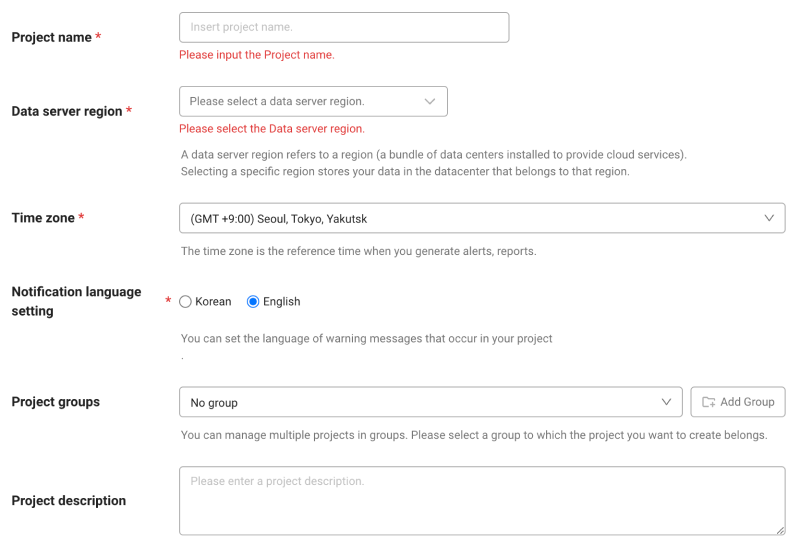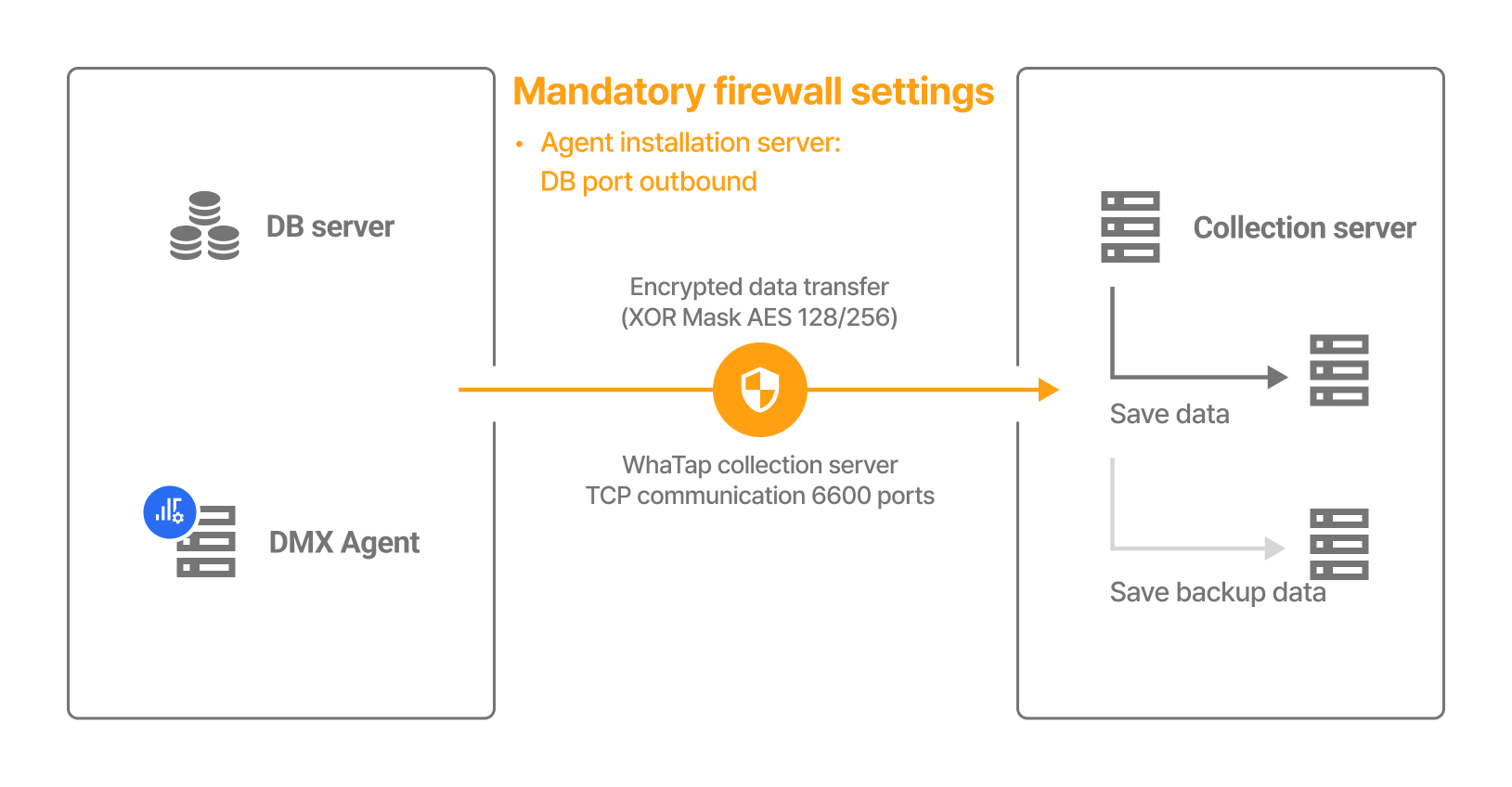Agent Installation
The following guides you to the basic installation method for using the WhaTap database monitoring service.
To use the WhaTap monitoring service, after Sign in, create a project and install the agent to the target server. For more information about registration as a member, see the following.
Creating a project
Create a project before installing the agent.
-
Log in WhaTap monitoring service.
-
To create a project, on the left of the screen, select All Projects > + Project.
-
Select a product in Select product for installation.
-
Configure the settings for Project name, Data server region, and Time zone.

-
In Notification language setting, select the language for alert messages.
-
After all settings are finished, select Creating a project.
-
A Data server region refers to a region (a bundle of data centers installed to provide cloud services). Selecting a specific region stores your data in the datacenter that belongs to that region.
-
Time zone is the reference time for generating alerts and reports.
-
To group multiple projects for management, select a group from Project groups or add a group. For more information about grouping, see the following.
-
To add a project with an organization selected, Groups of organization must be set.
Checking the configuration diagram
It is the configuration to install the agent on the database server for Oracle Pro monitoring.

Firewall settings are required and all data is transmitted encrypted. The port 6600 is used for communication with the WhaTap collection server. Create an account with roles required for database monitoring. Log in with the root account and then create accounts. To use the previous accounts, go to Create DB User File. If you do not have any permission, you may not be able to proceed with normal monitoring. In the example code, Account creation
whatap is the DB user account name. Change it to your account name.
DB_Password in the example code.
-
In general cases
SQLcreate user whatap identified by DB_Password;
grant create session to whatap;
grant select any dictionary to whatap; -
Multi-tenant in 12c or later: Add the prefix
c##.SQLcreate user c##whatap identified by DB_Password;
grant reate session to c##whatap;
grant select any dictionary to c##whatap;
alter user c##whatap set container_data = ALL container = CURRENT; -
In case of using the kill session
SQLgrant alter system to whatap;
Support features for each role
The roles other than the Default role do not need to be assigned depending on the environment. However, some functions may not work.
| Role | command (Single DB) | command (Multitenant DB) | Menu and feature | Details |
|---|---|---|---|---|
| Default role | grant create session to whatap; | grant create session to c##whatap; | Access | - |
grant select any dictionary to whatap; | grant select any dictionary to c##whatap; | Monitoring a Database Instance / Monitoring Multiple Instances / SQL Statistics | When granting individual roles, see the following table | |
| - | alter user c##whatap set container_data = ALL container = CURRENT; | When using a multi-tenant DB (12C or higher), this is a required role to query the pdb. | ||
| Session kill | grant alter system to whatap; | grant alter system to c##whatap; | Active sessions > Session kill | - |
| Hidden parameter query | create view sys.whatap_vw_ksppi as select * from sys.x$ksppi;grant select on sys.whatap_vw_ksppi to DB_User;create synonym DB_User.whatap_vw_ksppi for sys.whatap_vw_ksppi; | Hidden parameters are included in the parameter query menu. | To query hidden parameters, separate view/synonym creation and role assignment are required. | |
create view sys.whatap_vw_ksppcv as select * from sys.x$ksppcv;grant select on sys.whatap_vw_ksppcv to DB_User;create synonym DB_User.whatap_vw_ksppcv for sys.whatap_vw_ksppcv; | ||||
Instead of select any dictionary, you can grant the following roles individually.
| Role | command (Single DB) | command (Multitenant DB) |
|---|---|---|
| Active sessions / Lock tree / Metrics information | grant select on v_$sqlarea to whatap; | grant select on v_$sqlarea to c##whatap; |
grant select on v_$transaction to whatap; | grant select on v_$transaction to c##whatap; | |
grant select on v_$instance to whatap; | grant select on v_$instance to c##whatap; | |
grant select on v_$sysstat to whatap; | grant select on v_$sysstat to c##whatap; | |
grant select on v_$lock to whatap; | grant select on v_$lock to c##whatap; | |
grant select on v_$sesstat to whatap; | grant select on v_$sesstat to c##whatap; | |
grant select on v_$event_name to whatap; | grant select on v_$event_name to c##whatap; | |
grant select on v_$session to whatap; | grant select on v_$session to c##whatap; | |
grant select on v_$sql to whatap; | grant select on v_$sql to c##whatap; | |
grant select on v_$process to whatap; | grant select on v_$process to c##whatap; | |
grant select on v_$statname to whatap; | grant select on v_$statname to c##whatap; | |
grant select on v_$system_event to whatap; | grant select on v_$system_event to c##whatap; | |
grant select on v_$osstat to whatap; | grant select on v_$osstat to c##whatap; | |
grant select on v_$px_session to whatap; | grant select on v_$px_session to c##whatap; | |
grant select on v_$sga to whatap; | grant select on v_$sga to c##whatap; | |
| - | grant select on v_$con_sysstat to c##whatap; | |
| Parameter information | grant select on v_$parameter to whatap; | grant select on v_$parameter to c##whatap; |
| Wait information / Event information | grant select on v_$event_name to whatap; | grant select on v_$event_name to c##whatap; |
grant select on v_$system_event to whatap | grant select on v_$con_system_event to c##whatap; | |
grant select on v_$system_wait_class to whatap; | grant select on v_$system_wait_class to c##whatap; | |
| - | grant select on v_$con_system_wait_class to c##whatap; | |
| Tablespace information | grant select on dba_data_files to whatap; | grant select on cdb_data_files to c##whatap; |
grant select on dba_free_space to whatap; | grant select on cdb_free_space to c##whatap; | |
grant select on dba_temp_files to whatap; | grant select on v_$sort_segment to c##whatap; | |
grant select on v_$temp_extent_pool to whatap; | grant select on v_$tempfile to c##whatap; | |
grant select on v_$containers to whatap; (12c 이상) | grant select on v_$containers to c##whatap; |
Checking the access key
The access key is the unique ID to enable the WhaTap service.
In the installation guide section, select Getting the access key. After the access key has been issued automatically, proceed to the next step.
After a project has been created, the Agent installation page appears automatically. If the Agent installation does not appear, select Management > Agent installation on the left of the screen.
Download agent
On the agent Installation screen, select the Oracle version that matches your environment and then select Download.
For users who cannot download tar files due to security settings, ZIP files are also provided. On the installation screen, select the .zip Download button.
Agent CONFIG.
The agent is recommended to be installed with an Oracle account and the Oracle connection environment variables must have been set. Proceed with the agent configuration in the following order.
In case of installation from the user account other than the Oracle account
-
You need the role (
read) to read the shared memory created by Oracle. -
If the
permsvalue is 640 in the output of theipcs -mcommand, the agent can be installed by another account in the same group. -
If the
permsvalue is ** 600 ** and ** in the result of theipcs -mcommand for Oracle 12c r2 or later, you can set the parameter to change the perms value to ** 640 ** as follows. To apply the changes, restart the DB.alter system set allow_group_access_to_sga=true scope=spfile;
whatap.conf configuration
Go to the unzipped folder and then check the whatap.conf file. In whatap.conf, enter the project access key, WhaTap server data, and ipckey.
license={AccessKey}
whatap.server.host=13.124.11.223/13.209.172.35 # WhaTap server information
ipckey={ipckey}
-
The
ipckeyoption value can be acquired via theipcs -mcommand. This is the key value (hexadecimal) of the Oracle to be monitored. -
If you have installed multiple databases on a server, see the following to enter the
ipckey.
Creating the initial configuration file
To create an initial configuration file, connect to the database with the SYS account (or an equivalent account) to receive and process information. The account and password are not saved.
./dmxinit.sh {sys_user} {sys_password}
After execj\uting the command, the following five files are created:
dmx.init, class.init, dbname.init, stat.init, event.init
-
If you can connect without
sys_userandsys_password(as connecting withsqlplus '/as sysdba'), you do not need to addsys_userandsys_passwordas arguments.BASH./dmxinit.sh -
If the
sys_userandsys_passwordstrings contain special characters, add the escape character (\) before each special character.BASH./dmxinit.sh whatap whatap\!\@pwd
DB user file creation
Generate an encrypted UID for database connection. Enter the username and password and then run the shell script (or batch file).
./uid.sh {DB_USER} {DB_PASSWORD}
-
After setting it once, it collects data from the database server to be monitored through the encrypted UID.
-
To create a DB user file, enter the project access key in the whatap.conf file. Checking the access key
-
In the Azure database environment, enter
DB_USERin the form of DB_USER@DB_name. -
If special characters are included in
DB_USERorDB_PASSWORD, enter the escape character (\) together before any special characters.Example./uid.sh whatap whatap\!pwd
# If there are multiple special characters, add the escape character(\) for each.
./uid.sh whatap whatap\!\@pwd
Starting the monitoring
Execute a shell script (or batch file) from the path where you have installed the agent.
./start.sh
To use it like a daemon, execute the following command. However, it works only in the environment where nohup has been installed.
./startd.sh
Next steps
-
Checking the installation
If you have created a project, installed an agent, and applied all agent options, see the checklist in the following.
-
Installation troubleshooting
It provides various problems that may occur when installing the agent and specific instructions for resolving them. For more information, see the following.
-
Agent setting
It provides various features for monitoring by applying some options to the agent configuration file (whatap.conf). For more information, see the following.
-
Starting the monitoring
After configuring all settings, the agent starts collecting metrics data from the database server. First, check whether the monitoring data has been collected in Instance List. For more information about Instance List, see the following.